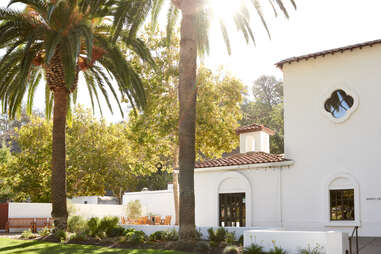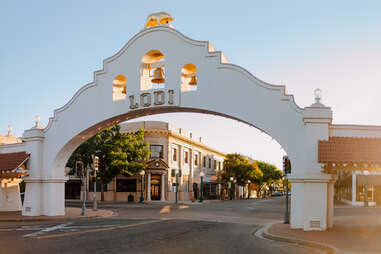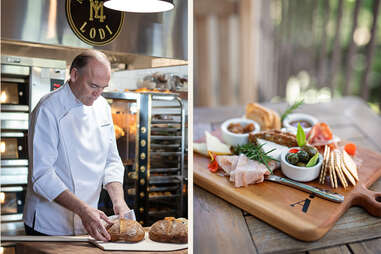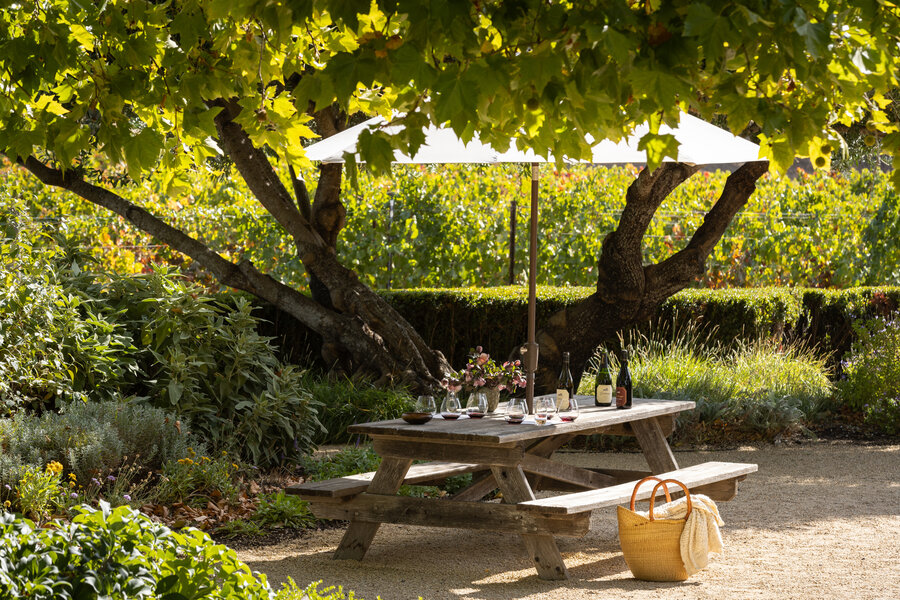California Wine Country is renowned for both its natural beauty and for the world-class cabernet sauvignon, chardonnay, and pinot noir (among other varietals) it produces. The area’s tentpole regions, Napa Valley and Sonoma County, however, are famous for something much less enticing: high prices. Napa, in particular, has grown wildly expensive, with the average tasting fee soaring above $80 and most of the best-known wineries now operating on a reservation-only basis. (Sonoma, long considered the laid-back alternative to Napa, isn’t far behind, averaging $72 for a tasting fee.)
The good news for oenophiles on a budget is that Northern California has plenty of options for wine tourism that are considerably more affordable and less crowded. An additional benefit to visiting less renowned locales is that the tasting rooms can have a more personal touch: In places like the Anderson Valley, Livermore, and Lodi, it’s not rare for the actual winemaker to be the one pouring your flight and telling you about the wines — which are quite often excellent.
Here’s a look at what makes these three regions special — not just as alternatives to Napa, but as destinations in their own right.

 Roederer Estate is in the heart of the Anderson Valley. | Courtesy of Roederer Estate
Roederer Estate is in the heart of the Anderson Valley. | Courtesy of Roederer Estate
Anderson Valley
The primary reason the Anderson Valley has stayed mostly under the radar is obvious: It’s a haul to get there. The valley’s largest town, Boonville (population 1,018), is a two-and-a-half-hour drive from San Francisco, a good stretch of that on a winding canyon road. Those who make the journey to this remote pocket of Mendocino County, however, will discover a pastoral landscape of steep hills lined with oak and redwood trees. They’ll also find some of the best pinot noir and sparkling wine in California.
While vineyards were planted here as far back as the late 19th century, the area — California’s coolest wine-growing region — truly found its viticultural footing in the 1970s, when small wineries such as Husch Vineyards and Navarro Vineyards began putting out attention-grabbing bottlings of pinot noir, gewürztraminer, and more. A few bigger dogs would follow, such as Dan and Margaret Duckhorn, the founders of acclaimed Napa Valley merlot-makers Duckhorn Vineyards, who founded Goldenye here in 1996.
“Dan and Margaret traveled all over the state to find the ideal location to grow exceptional pinot noir,” says Goldeneye winemaker Kristen McMahan. “Dan really just kind of fell in love with the area and saw the potential here. We get those reliable coastal breezes that keep everything cool and dry, and a large diurnal swing that allows the grapes to ripen properly, but also to preserve natural acidity.”
Pinot noir and chardonnay are the main grapes used in Champagne, so it’s little surprise that the French took notice as well. In 1982, Louis Roederer, the maison best known for making Cristal, chose the Anderson Valley as the site for its first property outside of France, Roederer Estate.
“Anderson Valley was still very undeveloped, and also the coldest growing region in California, so perfect for sparkling wine,” says Nicole Carter, Roederer Collection’s president of U.S. wineries, who notes that Roederer now farms about a quarter of the vineyards in the appellation.
Beyond the luxury experiences available at Goldeneye and Roederer, the latter of which recently debuted a major renovation of its tasting room, the valley isn’t that much more developed than it was 40 years ago. A few new restaurants have popped up, like Jumbo’s Win Win, a roadhouse from a former co-owner of the award-winning San Francisco cocktail bar Trick Dog, but many of the wineries here remain informal. At Navarro, for example, you can belly up to the bar and taste as many wines as you want for $10. In many ways, it’s the closest you’ll get to experiencing what Napa was like before the big money arrived. Looking for another Napa connection? The Boonville Hotel is run by the family who owned the French Laundry before Thomas Keller.

 Wente Family Vineyards in Livermore offers wine tastings seven days a week at its tasting room. | Courtesy Wente Family Vineyards
Wente Family Vineyards in Livermore offers wine tastings seven days a week at its tasting room. | Courtesy Wente Family Vineyards
Livermore
Don’t want to venture quite so far from civilization? Livermore, an East Bay suburb just an hour’s drive from San Francisco, offers another under-the-radar alternative, this one with a rich history. Spanish missionaries planted vines here all the way back in the 1760s, and 19th-century pioneers such as C.H. Wente and James Concannon founded commercial vineyards here in the 1880s. Wente Family Vineyards produced the world’s first varietally labeled chardonnay (the French typically label their wines by region, not varietal), and around three-quarters of the chardonnay planted in California today traces back to a clone from Wente.
“My great-grandfather came from Germany to Livermore, but he made a pit stop in Napa, where he learned to grow and make wine under Charles Krug,” says Aly Wente, the vice president of marketing and customer experiences at Wente Family Vineyards. “The Livermore Valley was known for its incredible climate and a terroir similar to Napa, and had already had some early winemaking pioneers like Charles Wetmore, who specifically chose Livermore because he thought it had the most similar climate to Bordeaux.”
It’s no surprise, then, that many of the vineyards here focus on Bordeaux varietals. In fact, earlier this year Livermore named cabernet franc and sauvignon blanc, both of which are often associated with Bordeaux, the region’s “signature” grapes. There’s a historical basis for this, according to Brandi Lombardi, executive director of the Livermore Valley Wine Community: “In 1882, Charles Wetmore planted cuttings of sauvignon blanc and semillon from Château d’Yquem. Wine from these grapes won the Grand Prize at the 1889 Paris Expo, becoming the first American wine ever to win a prize in France.”
Of course, Livermore looks a lot different now from the way it did in Wetmore’s day: It’s a suburb with a giant freeway and an assortment of big box stores. On the flipside, there are also around 50 tasting rooms — with a flight typically ranging $20 to $40 — and a downtown with a booming restaurant scene featuring places like Range Life, whose chef worked at San Francisco’s Bar Tartine and Tartine Manufactory, and Wingen Bakery. If you want to stay in town, there’s a nice Wine Country–style boutique hotel, the Purple Orchid Resort, as well as The Rose Hotel, on neighboring Pleasanton’s charming Main Street. Or, you know, you can just day trip from the city.
“What is really important to know about Livermore Valley is that we pride ourselves on the
community, and that welcoming feeling you get,” Lombardi says. “It’s not unusual to find the winemaker behind the tasting room bar pouring your glass of wine and enthusiastically conversing with you.”

 Lodi’s historic downtown is filled with tasting rooms, restaurants, and shops. | Courtesy Visit Lodi
Lodi’s historic downtown is filled with tasting rooms, restaurants, and shops. | Courtesy Visit Lodi
Lodi
If the name Lodi rings a bell, it’s probably from the namesake Creedence Clearwater Revival song, in which John Fogerty laments, “Oh, Lord, I’m stuck in Lodi again.” A wine lover on a budget, however, might not feel so stuck in this small Central Valley city, located 35 miles south of Sacramento and a 90-minute drive east of San Francisco. Long pigeonholed as a grower of grapes for low-cost bulk wines, Lodi is also home to California’s highest concentration of old zinfandel vines, some of them planted more than 100 years ago. The age of these vines means they produce low yields of highly concentrated fruit that produce high-quality wines, often at very reasonable prices: For example, the OVZ from Oak Ridge retails for just $15, and Wine Enthusiast gave the 2021 bottling 93 points.
“We’ve been growing zinfandel for over 100 years, and that wisdom has been passed down from generation to generation,” says Stephanie L. Bolton, the research and education director for the Lodi Winegrape Commission. “Lodi helped me fall in love with the zinfandel grape.”
As much as zin is the region’s calling card, a number of wineries are also experimenting with surprising varieties. Acquiesce, for instance, focuses on whites such as grenache blanc, viognier, and bourboulenc; Markus Wine Co. makes tasty grüner veltliner; and Perlegos Family Wine Co. specializes in the Greek grape assyrtiko.
Lodi is also a great place for a beginner to learn about wine. The Lodi Wine Visitor Center has more than 200 bottles on hand, none of them over $70, and a four-pour tasting costs just $12. “The entire staff is trained to help people learn which wineries to visit based on their individual desires,” Bolton says.

 Chef Charlie Palmer opened Maison Lodi, one of two restaurants at his Appellation Lodi – Wine & Roses Resort and Spa, earlier this year. | Courtesy Appellation
Chef Charlie Palmer opened Maison Lodi, one of two restaurants at his Appellation Lodi – Wine & Roses Resort and Spa, earlier this year. | Courtesy Appellation
While the wine in Lodi can be quite good, the region has long lagged behind California’s more glamorous wine regions in terms of hospitality and dining options. That’s beginning to change, though, as heavy hitters have clocked the area as a diamond in the rough. Michelin-starred chef Charlie Palmer, for starters, is a co-owner of the recently reimagined Appellation Lodi – Wine & Roses Resort and Spa, where he recently opened a café, Maison Lodi, and a farm-to-table restaurant, Americana House.
“For me, the decision to come to Lodi feels very similar to the decision I made more than 20 years ago, when I moved my family to Healdsburg,” Palmer says. “At that time, Healdsburg was not yet the culinary and wine destination it’s known as today, but I could see all the right ingredients were there: world-class agriculture, passionate vintners, and a strong community fabric. Lodi is in that same moment now.”


Dining and Cooking